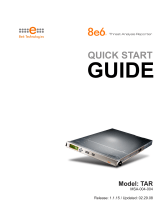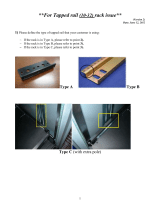
6 8e6 ThreaT analysis reporTer Quick sTarT Guide
Rack Mount the Server
Rack Setup Precautions
Warning:
Before rack mounting the server, the physical environment should be set up to safely ac-
commodate the server. Be sure that:
The weight of all units in the rack is evenly distributed. Mounting of the equipment in
the rack should be such that a hazardous condition is not achieved due to uneven
mechanical loading.
The rack will not tip over when the server is mounted, even when the unit is fully
extended from the rack.
For a single rack installation, stabilizers are attached to the rack.
For multiple rack installations, racks are coupled together.
Reliable earthing of rack-mounted equipment is maintained at all times. Particular
attention should be given to supply connections other than direct connections to the
branch circuit (e.g. use of power strips).
A power cord will be long enough to t into the server when properly mounted in the
rack and will be able to supply power to the unit.
The connection of the server to the power supply will not overload any circuits. Con-
sideration should be given to the connection of the equipment to the supply circuit
and the effect that overloading of the circuits might have on overcurrent protection
and supply wiring. Appropriate consideration of equipment nameplate ratings should
be used when addressing this concern.
The server is only connected to a properly rated supply circuit. Reliable earthing
(grounding) of rack-mounted equipment should be maintained.
The air ow through the server’s fan or vents is not restricted. Installation of the
equipment in a rack should be such that the amount of air ow required for safe op-
eration of the equipment is not compromised.
The maximum operating ambient temperature does not exceed 104°F (40°C). If
installed in a closed or multi-unit rack assembly, the operating ambient temperature
of the rack environment may be greater than room ambient. Therefore, consideration
should be given to installing the equipment in an environment compatible with the
maximum ambient temperature (Tma) specied by the manufacturer.
WARNING: Extend only one component at a time. Extending two or more
components simultaneously may cause the rack to become unstable.
•
•
•
•
•
•
•
•
•
•






















